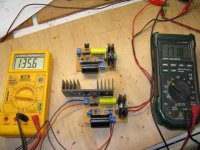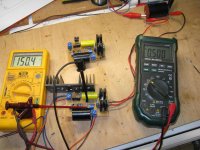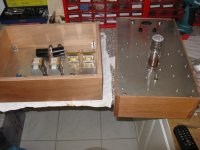In working state the CCS is gonna have only the Vin-Vout drop across. Its all a matter of start up and transient garbage. The zeners on the gates help, but we never know.
In working state the CCS is gonna have only the Vin-Vout drop across. Its all a matter of start up and transient garbage. The zeners on the gates help, but we never know.
So, do you think I could give it a try?
SSHV2 B.O.M.
Q1-2 DN2450
Q3 IRF840
Q4-5 KSA1381
Q6 2SK117GR
IDSS? HEATSINKS FOR IRF840 & MINI-HEATSINKS FOR KSA1381?
D1-2-3 Z12V 0.5W
D4 LED VALUE?
R1-2 100R
R3 330R
VR4 500R
R5 10R
R6 1R86
R7 100R
R8 1K
R9-10 68K 2W
VR11 500R
R12 1K
C1 0.33uF
C2 10uF
**
Salas.....SSHV2....R8....in my application should I use 1K or 1.8K...or other value....thankyou.
The LED can be RED, or ORANGE, or GREEN, or YELLOW.
Each colour comes within a range of voltage and that voltage range varies markedly with production method and manufacturer.
Expect 1.55V to 2.1V as the range within which all those "normal leaded end" LEDs will fall.
You have to measure the as built circuit to confirm what currents are passing individual components. Then adjust component values if necessary.
Each colour comes within a range of voltage and that voltage range varies markedly with production method and manufacturer.
Expect 1.55V to 2.1V as the range within which all those "normal leaded end" LEDs will fall.
You have to measure the as built circuit to confirm what currents are passing individual components. Then adjust component values if necessary.
**
Salas.....SSHV2....R8....in my application should I use 1K or 1.8K...or other value....thankyou.
R8=1K8 is the correct value, and its crucial to SOA.
LOL
SOA= Safe Operating Area 😀
Audiofanatic 😀
SOA = ?? son of ???? 🙂
SOA= Safe Operating Area 😀
Audiofanatic 😀
So be it.....the son of the area.....learn something new everyday....a very good forum.....enjoying it...
Today I decided to finish my second SSHV2 for the pre I am building.
Both shunts on the test bed working nicely, and voltage is very stable.
Just be careful if you use long cables without any decoupling. I managed to get it into oscillation with very long test cables. A cap near the input and everything is fine. Nothing burned this time, but future builders do not take the risk.
Both shunts on the test bed working nicely, and voltage is very stable.
Just be careful if you use long cables without any decoupling. I managed to get it into oscillation with very long test cables. A cap near the input and everything is fine. Nothing burned this time, but future builders do not take the risk.
Attachments
Today I decided to finish my second SSHV2 for the pre I am building.
Both shunts on the test bed working nicely, and voltage is very stable.
Just be careful if you use long cables without any decoupling. I managed to get it into oscillation with very long test cables. A cap near the input and everything is fine. Nothing burned this time, but future builders do not take the risk.
Just curiosity, wich pre are you building?
Please when you can post pics in the #26 thread. I'm very interested, still pending to buy the boxes so if I see your #26 I will have an idea. Nick sorry for OT.
Thanks for the pics, congratulations looks very good. Where are the mains transformers & B+ chokes, inside the box where is the tube rectifier? I use also the same AVC volume control & output tx, did you bought to Thomas as me?
Power transformer 2x220V, 5R4GY rectifier, choke input ll1673, ll1660PP for output transformer and AVC from Intact audio.
Also got some nice BIG 10ohm 100W Dale resistor for filament bias.
Also got some nice BIG 10ohm 100W Dale resistor for filament bias.
- Home
- Amplifiers
- Power Supplies
- Simplistic mosFET HV Shunt Regs


